Stand Up Paddle boarding (SUP) is a great and cost-efficient way to experience the water. But before you head out, there are some safety precautions and paddling tips you should know.
In this comprehensive article, we’ll discuss how to stand up paddle board for beginners as well as some other SUP basics.
Gear You’ll Need to Start Paddleboarding
Before you even start to stand up paddle board, you’ll need to get various pieces of equipment.
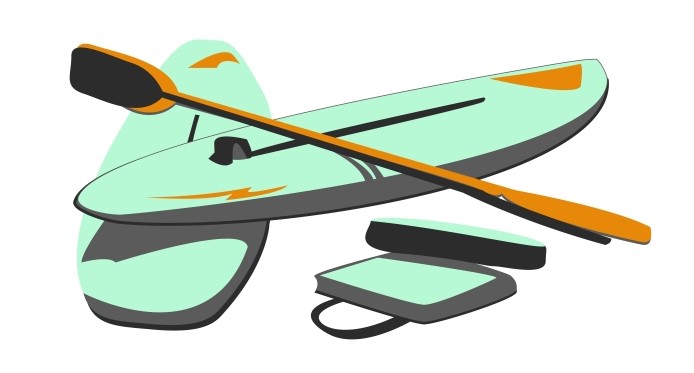
- Paddle Board − There are many different types and variations. We’ll get more into that later.
- Paddle − We’ll explain how to choose the right material and dimensions for you in a minute.
- PFD (Personal Flotation Device) − No matter how good of a swimmer you are, always wear a PFD. Here’s how to choose a Coast Guard Approved PFD.
- SUP Leash − included with most paddle boards, it keeps your board close if you fall off.
- Proper Clothing − Wear UV-resistant clothes that will wick water away. Generally, they will be made of polyester or other synthetic fabrics.
- Sunscreen − Even on cloudy days, you should never underestimate UV rays in summer.
- Bottle Of Water − Often overlooked, a bottle of water will help you avoid dehydration, which is fairly common on hot days. If you really can’t bring a bottle of water with you, drink A LOT beforehand.
- Safety Whistle − It doesn’t take any room and it can save your life. Don’t take unnecessary risks.
- Safety Light − Same as above, if you think you’ll be paddling at night.
- SUP Board Bag − Although not necessary, it will help you carry and protect your board. Almost always included with inflatable SUPs.
How to Choose the Right Stand Up Paddle Board
Inflatable vs Hard-Sided SUPs
The first SUPs were hard-sided with a foam core coated in fiberglass that added durability and rigidity.
These are harder to damage and generally have more versatile designs able to accommodate a range of activities.
Inflatable kayaks are newer. Exactly what they sound like, inflatable boards are lighter and easier to transport and store.
They’re not as flimsy as you may think and are solid enough to absorb many drops or scrapes without puncturing.
But you won’t be able to coax the same performance out of an inflatable.
Different Types of Paddle Boards
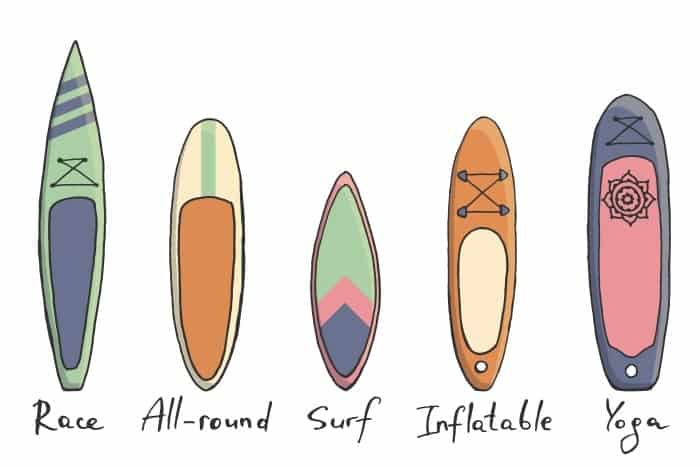
- All Around SUPs: The most common model, these are versatile boards able to handle a variety of conditions. While they don’t excel in any one category, they’re stable enough for those new to the sport while still challenging experienced paddlers.
- Yoga SUPs: Yoga specific boards have a large deck to give you plenty of room to practice. You can find both hard-sided and inflatable yoga boards, but inflatables allow you to sit a little higher in the water and keep you dry. The bigger design makes them stable and ideal for newcomers.
- Touring SUPs: Narrower and more streamlined than other types. Touring boards are designed for speed. Most hulls are built to displace water. This improves tracking and makes your paddle stroke more efficient.
- Surf SUPs: Maneuverable and responsive, the surf designs are the sport cars of the SUP universe. They’re tippier than other types but handle waves better. They’re not the best for newcomers and take some getting used to before they can be mastered.
- Fishing SUPs: These boards are also wider than most so you have room to fit extra gear. Some have accessory mounts to secure bait trays, cameras, or an anchor.
How to Choose a Paddle
Paddles can be made of many different materials including fiberglass, wood, carbon fiber, or plastic.
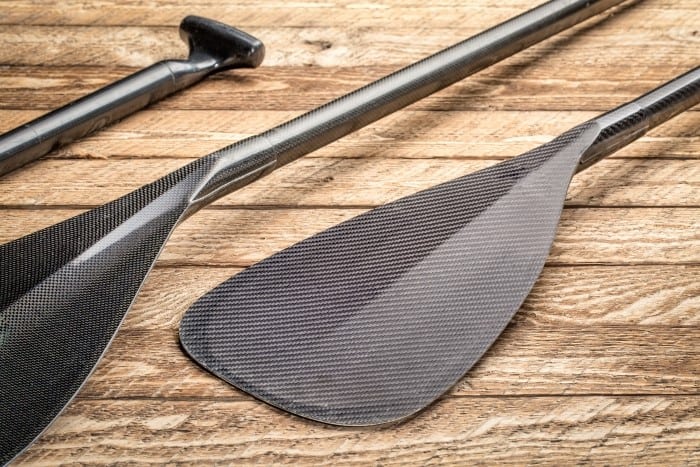
If you plan on spending a lot of time in the surf or shallow water, I’d recommend a tougher and heavier paddle made of plastic.
Fiberglass and carbon fiber are lighter and better for longer trips. Wood paddles look good on the water and are often given a clear gel coat or fiberglass finish to increase their strength. They require more upkeep though and are heavier.
When selecting a paddle, look for one that is between six and twelve inches taller than you. This will allow it to fit in a comfortable position when the blade’s in the water. A longer paddle will work better in calm water and a shorter one in surf.
You can find different sizing techniques here for a more precise measurement.
Standing & Keeping Your Balance
When you’re just starting out, give yourself time to get comfortable. Start in a calm and protected area with minimal wind or boat traffic. Use a board that is at least 30 inches wide and has a length of 11 feet or longer to maximize stability. If it feels wobbly after a few tries, try a wider or longer board. The wider and thicker the board, the more stable it will be.
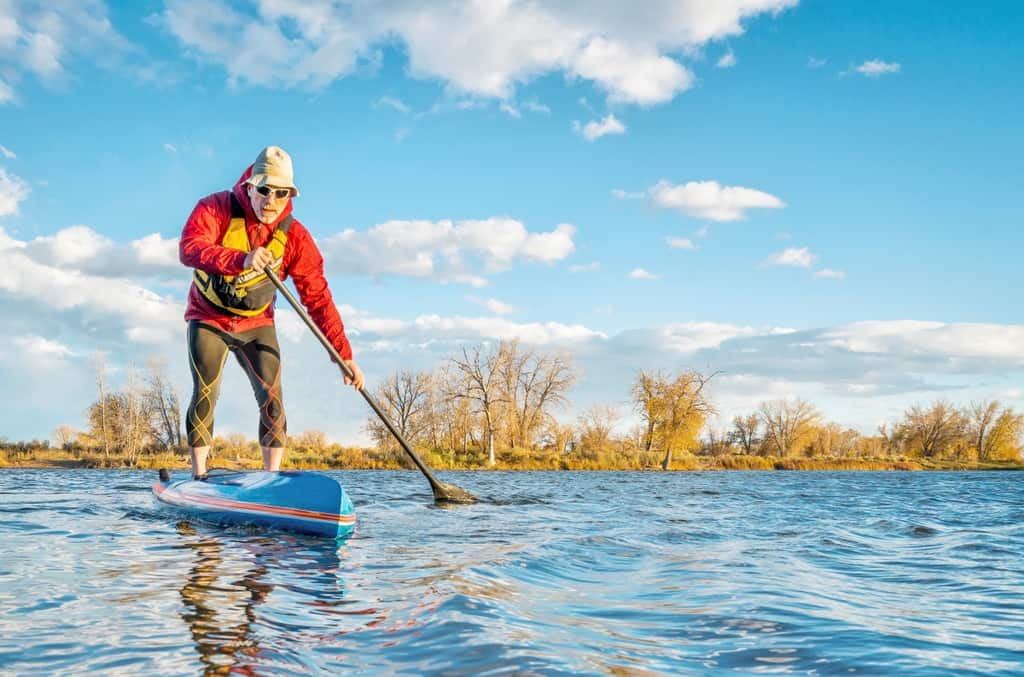
Push the board out from shore so that the fin isn’t dragging on the bottom. Climb on, keeping your body and center of gravity as low and centered as possible. Carefully rise to a kneeling position. If the board feels stable, take a few paddle strokes on each side.
Keeping your center of gravity in the middle of the board, stand up slowly one leg at a time. Keep your feet shoulder length apart and parallel. Paddle with your knees bent to absorb any rocking.
If you do fall off, most SUPs are stable enough to allow for an easy recovery. If the water is cold or you chill easily, consider wearing a wet-suit to make your time in the water more comfortable. It will also help alleviate fear of falling in if that makes you nervous.
Basic Paddling Skills
It may seem natural to let your arms do most of the work when you paddle. But you’ll move quicker if you utilize the larger muscles in your core.
Whenever you paddle push with your top hand while pulling with your bottom, this will activate your abdominal and back muscles and increase your efficiency.
How To Hold Your Paddle
Keep one hand on the top of the paddle and the other along the shaft. Make sure your feet stay parallel and pointed towards the bow.
When you dip the paddle in the water, place just the blade beneath the surface. Immersing the shaft will increase drag and slow you down.
Forward Stroke
Use your lower arm as a pivot by keeping it relatively stiff and still. Use your top arm as the lever, pulling it toward you to extend the paddle out in front. Rotate your top shoulder and extend the paddle as far in front of you as possible to immerse the blade.
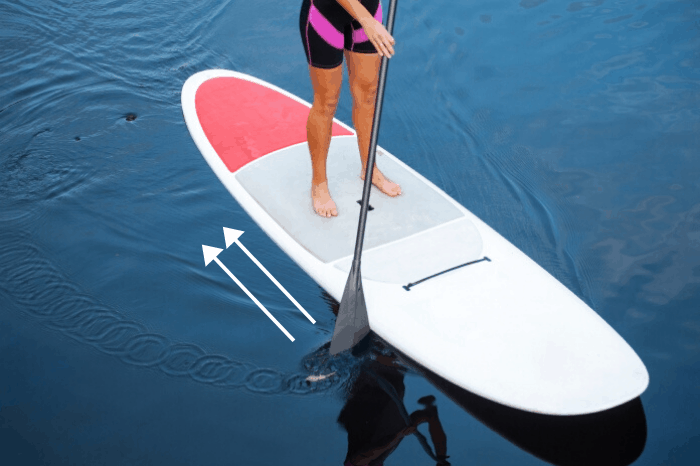
Draw your lower hand back toward you while pushing with your top hand. This will engage your abs and make your stroke more efficient.
To avoid turning in circles, alternate which side of the board your paddle is on every few strokes.
Reverse Stroke
To slow down or go back, place the blade near the stern of the board and pull it back towards you while twisting your core in the opposite direction.
A more forceful stroke will cause the bow to turn to the opposite side of your paddle (i.e. if your paddle is on the left side the bow will turn right). Use a calmer stroke closer to your board to minimize this turning effect.
Sharper reverse turns can be made by swinging the paddle further out from the board.
How to Turn − Beginner Technique & Sweep Stroke
The simplest way to turn your paddle board is to place your paddle in the water with the blade turned perpendicular to the board. This maximizes the amount of surface area coming in contact with the water, creating drag and turning you sharply in the direction the paddle is on.
The drawback to this method is that all that drag slows you down. Once you have the board pointed in the direction you want, you’ll have to start from a stationary position again.
A more efficient turning method is called the sweep stroke. Bend your knees, and try to draw a wide arc with your paddle on the opposite side of where you want to turn.
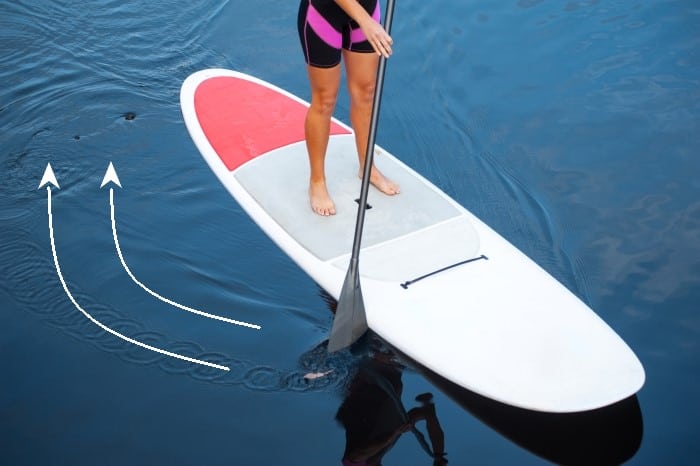
The wider the arc, the tighter the turn. Be careful as this will make you feel more unstable, so be sure to lower your center of gravity by bending your knees.
Getting Back on Your Stand Up Paddle Board
Should one of your aggressive forward strokes go awry, not to worry. Paddle boards are an easy platform to get back on. Unlike kayaks that can take on water which makes them less stable, you don’t have to worry about swamping a paddle board.
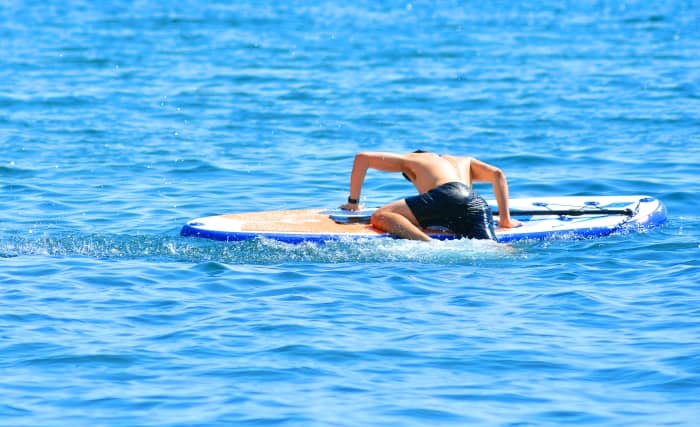
First and foremost, hold onto your paddle! Hopefully you’re wearing your SUP leash so you don’t have to worry about your board getting away from you. But it won’t do you a lot of good if your paddle is gone.
Use the board’s carrying handle to pull it toward you and rotate it until you’re near the center. Grab the opposite side of the board, pull it toward you, and kick hard while pushing yourself out of the water, similar to getting out of a swimming pool where you can’t touch the bottom.
Once back onboard, stay as low as you can until your legs feel steady underneath you. If you didn’t mean to fall it may be that the water is rough. Stay low until you feel comfortable standing, using the same method we discussed above.
Transporting Your Paddleboard
While inflatable SUPs are easy to move (albeit a little bulky), hard-sided boards can be challenging. Fortunately most designs aren’t very heavy, so while they’re a little awkward, they’re light enough for many to carry solo. Some boards have a carry handle designed into the middle so you can carry it much like you would a suitcase with a strap over the shoulder.
Shoulder Carry
Set your SUP on the ground and lift it by the tail. Walk towards the middle while raising it above your head. Once you’re centered, the board should be balanced on your head and you can transfer it to a shoulder. Reverse the process to set it down.
Car Racks
A necessity unless you own a truck with a decent-sized bed. Paddle boards can be secured to almost any vehicle with a surfboard rack. If you live in a densely populated area or your board will be unattended, consider purchasing a lock for your roof rack.
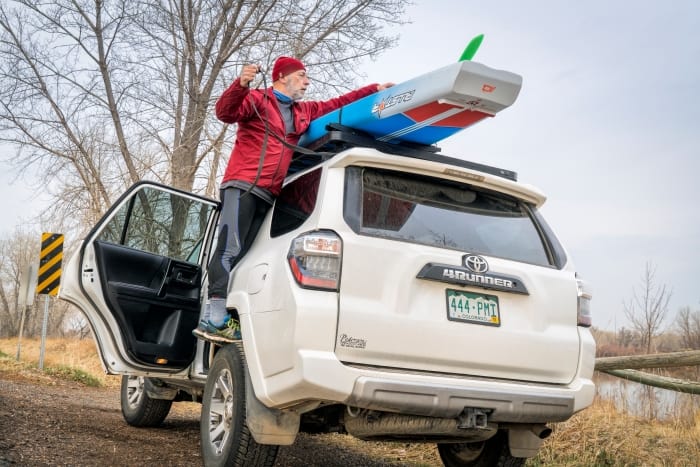
If you’re going a short distance that won’t require a trip on the freeway, you may be able to get away without using a roof rack and instead tying lines that wrap over your board and secure through your car’s windows.
Air Travel
There are many specialty bags to get your board on an airplane. These bags are built with extra padding for any extra jostling that may happen in flight. All the same, it’s not a bad idea to add even more padding, even if it’s just a couple of towels so it won’t move around inside the bag.
Final Paddleboarding Tips
- Choose a nice day. Remember that many bodies of water will experience strong afternoon winds on sunny days
- Minimize your sun exposure during the peak of the day to avoid sunburn and dehydration.
- Find a safe place to launch where boat’s and other beach goers won’t be in your way. Ideally the surf will be minimal too.
- It’s always best to paddle with a partner in case something goes wrong.
- Let your first trip be mellow and easy. Paddle boarding is hard work and you’ll tire faster than you think.
- Pack a few snacks if needed: paddle boarding can burn up to 500 calories per hour if you put your heart into it.
How to Stand Up Paddle Board – Conclusion
Paddle boarding is a great way to experience most waterways and get some exercise in the process. I hope after reading this you feel better prepared and inspired to hop on your board and take a trip yourself.
Did we miss anything? Have anything to add? Let us know in the comments below.



